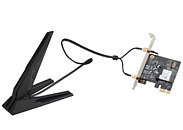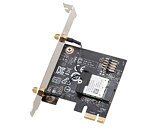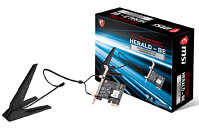- Joined
- Oct 9, 2007
- Messages
- 47,670 (7.43/day)
- Location
- Dublin, Ireland
| System Name | RBMK-1000 |
|---|---|
| Processor | AMD Ryzen 7 5700G |
| Motherboard | Gigabyte B550 AORUS Elite V2 |
| Cooling | DeepCool Gammax L240 V2 |
| Memory | 2x 16GB DDR4-3200 |
| Video Card(s) | Galax RTX 4070 Ti EX |
| Storage | Samsung 990 1TB |
| Display(s) | BenQ 1440p 60 Hz 27-inch |
| Case | Corsair Carbide 100R |
| Audio Device(s) | ASUS SupremeFX S1220A |
| Power Supply | Cooler Master MWE Gold 650W |
| Mouse | ASUS ROG Strix Impact |
| Keyboard | Gamdias Hermes E2 |
| Software | Windows 11 Pro |
MSI released the Herald BE NCM865, a PCIe wireless networking adapter that provides Wi-Fi 7 and Bluetooth 5.4 connectivity in a convenient internal add-on card form-factor. The features a PCI-Express x1 and USB 2.0 host interfaces. Besides installing the card on a PCIe slot, you connect it to a vacant USB 2.0 header on your motherboard with the included cable, for the Bluetooth component to work. The base card features the two antenna jacks, the USB 2.0 header, and an M.2 E-key slot which holds the actual WLAN module.
The WLAN module in charge of this card is a Qualcomm NCM865. This provides Wi-Fi 7 (IEEE 802.11be) at a maximum throughput of 5.8 Gbps. The controller supports 320 MHz wide channels across the 6 GHz, 5 GHz, and 2.4 GHz bands. It also supports older Wi-Fi standards going down to 802.11n over the 2.4 GHz band. Its Bluetooth component supports the latest Bluetooth 5.4 standard. The controller features multi-link operational topology. A stylish magnetized base antenna module comes included—the kind that MSI includes with some of its premium motherboards. The company didn't release pricing information.



View at TechPowerUp Main Site
The WLAN module in charge of this card is a Qualcomm NCM865. This provides Wi-Fi 7 (IEEE 802.11be) at a maximum throughput of 5.8 Gbps. The controller supports 320 MHz wide channels across the 6 GHz, 5 GHz, and 2.4 GHz bands. It also supports older Wi-Fi standards going down to 802.11n over the 2.4 GHz band. Its Bluetooth component supports the latest Bluetooth 5.4 standard. The controller features multi-link operational topology. A stylish magnetized base antenna module comes included—the kind that MSI includes with some of its premium motherboards. The company didn't release pricing information.



View at TechPowerUp Main Site





